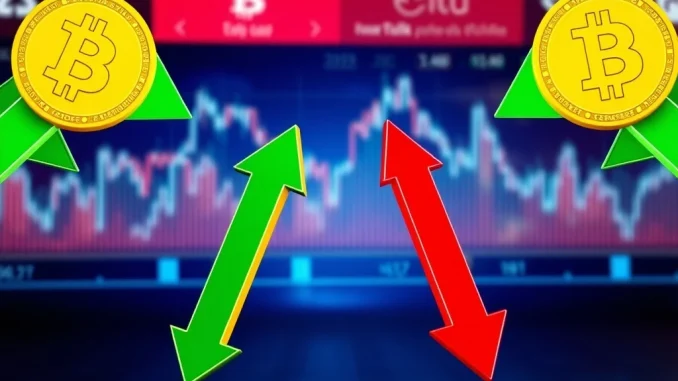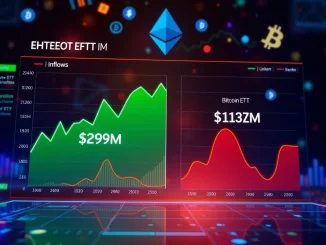
In the fast-paced world of cryptocurrency, understanding market sentiment is paramount. For traders and investors alike, deciphering the collective mood of the market can offer a significant edge. One of the most telling indicators in this regard, especially within the high-stakes realm of BTC perpetual futures, is the long-short ratio. This metric provides a snapshot of how many traders are betting on Bitcoin’s price to rise versus those expecting it to fall, offering crucial insights into prevailing Bitcoin trading sentiment.
Understanding the Dynamics of Long-Short Ratio in BTC Perpetual Futures
What exactly is a long-short ratio, and why should it matter to you, particularly when dealing with BTC perpetual futures? Simply put, it’s a measure of the proportion of long positions (bets on price increase) to short positions (bets on price decrease) on a given exchange or across the market. Perpetual futures contracts, unlike traditional futures, don’t have an expiry date, making them a popular instrument for leverage trading and continuous speculation.
A ratio above 1 typically indicates that more traders are long than short, suggesting bullish sentiment. Conversely, a ratio below 1 points towards a bearish outlook. When the ratio hovers around 1 (or 50/50 as presented in percentages), it signifies a relatively balanced market with mixed sentiment. However, extreme deviations can often precede significant price movements, making this a vital tool for crypto market insights.
Let’s dive into the recent 24-hour long-short ratios for BTC perpetual futures across some of the leading cryptocurrency exchanges, providing a clearer picture of current market positioning:
| Exchange | Long Positions (%) | Short Positions (%) |
|---|---|---|
| Total Market | 50.58% | 49.42% |
| Binance | 50.79% | 49.21% |
| Gate.io | 50.02% | 49.98% |
| Bybit | 53.28% | 46.72% |
From the data, we can observe that the overall market for BTC perpetual futures is currently leaning slightly bullish, with 50.58% of positions being long. This indicates a marginally positive Bitcoin trading sentiment across the board.
What Do These Numbers Tell Us About Bitcoin Trading Sentiment?
Analyzing the individual exchange data provides even more granular crypto market insights:
- Binance: With 50.79% long and 49.21% short, Binance, a major player in the derivative trading space, shows a sentiment closely mirroring the overall market. This slight lean towards long positions suggests a cautious optimism among its large user base.
- Gate.io: At 50.02% long and 49.98% short, Gate.io exhibits an almost perfectly balanced sentiment. This could indicate a highly indecisive market on this platform, where neither bulls nor bears have a significant upper hand, or perhaps a more diversified trading strategy among its users.
- Bybit: Standing out with 53.28% long and 46.72% short, Bybit shows the strongest bullish bias among the top three exchanges listed. This higher proportion of long positions suggests that traders on Bybit are notably more confident in Bitcoin’s upward price movement in the short term. This could be influenced by various factors, including the platform’s user demographics, specific trading incentives, or prevailing technical analysis setups favored by its traders.
While a slight majority of long positions across the board might seem positive, it’s crucial to remember that this data represents only a 24-hour window. Market sentiment can shift rapidly, especially in the volatile cryptocurrency landscape. Furthermore, a heavily skewed ratio can sometimes be a contrarian indicator, meaning if too many traders are on one side, a sharp move in the opposite direction could trigger a cascade of liquidations.
Leveraging Long-Short Ratios for Informed Derivative Trading
For those engaged in derivative trading, the long-short ratio is more than just a statistic; it’s a potential strategic tool. Here’s how traders often integrate this data:
- Confirmation of Trend: If the long-short ratio aligns with an existing price trend (e.g., high long ratio during an uptrend), it can confirm the strength of that trend.
- Contrarian Indicator: Extremely high or low ratios can sometimes signal an impending reversal. For instance, if the long ratio is excessively high, it might indicate an overcrowded long position, making the market vulnerable to a ‘long squeeze’ if prices start to fall.
- Liquidation Risks: A high concentration of positions on one side can highlight potential liquidation cascades. If prices move against the majority, forced liquidations can accelerate the price movement, creating opportunities or risks depending on your position.
- Inter-Exchange Comparison: As seen with Bybit, significant differences in ratios across exchanges can reveal unique market dynamics or liquidity pools, which can be exploited by arbitrageurs or provide insights into specific exchange-driven narratives.
However, it’s vital not to rely solely on this one metric. The long-short ratio should always be used in conjunction with other technical and fundamental analysis tools, such as funding rates, open interest, volume, and macroeconomic news. A holistic approach to crypto market insights is always the most robust.
The Broader Picture: Beyond Just Numbers
While the long-short ratio offers valuable quantitative insights, the qualitative aspects of Bitcoin trading sentiment are equally important. Major news events, regulatory announcements, technological advancements (like Bitcoin halving events or network upgrades), and even social media trends can dramatically influence market psychology. For example, a sudden positive regulatory announcement could quickly shift a balanced long-short ratio heavily towards long positions as optimism floods the market.
Moreover, the concept of ‘smart money’ versus ‘retail money’ often plays a role. Large institutional players might have different positioning strategies than individual retail traders. Understanding the composition of long and short positions (if such data were available) would provide even deeper insights. For now, the aggregated long-short ratio remains a powerful, accessible indicator for anyone tracking BTC perpetual futures.
Conclusion: Navigating the Waves of Bitcoin Trading Sentiment
The 24-hour long-short ratios for BTC perpetual futures offer a compelling glimpse into the current pulse of the Bitcoin market. With a slight lean towards long positions overall, and a more pronounced bullish bias on platforms like Bybit, the immediate sentiment appears cautiously optimistic. However, the near 50/50 split on Gate.io reminds us that the market remains finely balanced and susceptible to rapid shifts.
For anyone involved in derivative trading, incorporating this metric into your analytical toolkit can provide crucial crypto market insights. Remember, while the long-short ratio is a powerful indicator of Bitcoin trading sentiment, it’s most effective when combined with a comprehensive understanding of market fundamentals and technical analysis. Stay informed, stay analytical, and navigate the dynamic world of crypto trading with a clear perspective.



